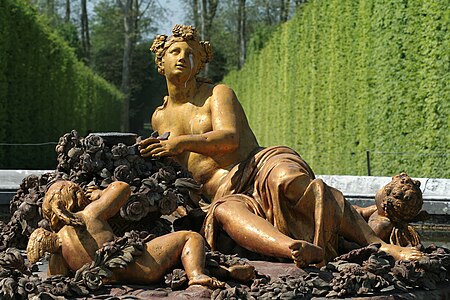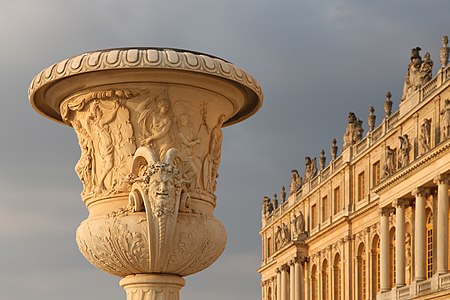Life
Tuby was born Giambattista Tubi in Rome in 1635, and first trained as a sculptor in Italy, before coming to France sometime after 1660. He was first engaged by the Gobelins Manufactory, headed by Charles Le Brun, the chief artist for the King. In 1664–65, he was employed making sculptures for the grottoes and terraces of the Chateau of Saint-Germain-en-Laye. [2] This led to major projects for the fountains and gardens of the Palace of Versailles, including the gilded lead sculpture of Apollo and his chariot for the Basin of Apollo (1668-71), the statues of the Rivers Saône and Rhone for the central basin (1683) and the statue of Flore. He also made a monumental statue of Peace and a large carved marble vase for the courtyard, and several other statues on mythological themes for the bouquets, or enclosed gardens, in the park. [1]
Le Rhône, La Saône, bronzes (1685-1688) Le vase de la paix, marbre (1685-1686). In addition to his work at Versailles, he collaborated on several projects with sculptor Antoine Coysevox, making a Pieta for the sepulcher of Jean-Baptiste Colbert, now in the Church of Saint-Eustache in Paris, and a bronze statue of Peace at the foot of the funeral monument to Cardinal Mazarin, in the Collège des Quatre-Nations (now the Institut de France). He also worked on the group of figures around the funeral monument to Marshal Turenne, originally in the Basilica of Saint-Denis, now at near the tomb of Napoleon at Les Invalides.
He was naturalized as a French citizen in 1672, and married the niece of Le Brun. Under Le Bruns's sponsorship he entered the new Royal Academy of Painting and Sculpture in 1676. [1]

Jean-Baptiste Colbert was a French statesman who served as First Minister of State from 1661 until his death in 1683 under the rule of King Louis XIV. His lasting impact on the organization of the country's politics and markets, known as Colbertism, a doctrine often characterized as a variant of mercantilism, earned him the nickname le Grand Colbert.

François Girardon was a French sculptor of the Louis XIV style or French Baroque, best known for his statues and busts of Louis XIV and for his statuary in the gardens of the Palace of Versailles.

Charles Antoine Coysevox, was a French sculptor in the Baroque and Louis XIV style, best known for his sculpture decorating the gardens and Palace of Versailles and his portrait busts.

The Saxon Garden is a 15.5–hectare public garden in central (Śródmieście) Warsaw, Poland, facing Piłsudski Square. It is the oldest public park in the city. Founded in the late 17th century, it was opened to the public in 1727 as one of the first publicly accessible parks in the world.

In the French formal garden, a bosquet is a formal plantation of trees in a wide variety of forms, some open at the bottom and others not. At a minimum a bosquet can be five trees of identical species planted as a quincunx, or set in strict regularity as to rank and file, so that the trunks line up as one passes along either face. In large gardens they were dense artificial woodland, often covering large areas, with tall hedges on the outside and other trees inside the hedges. Symbolic of order in a humanized and tamed gardens of the French Renaissance and Baroque French formal gardens, the bosquet is an analogue of the orderly orchard, an amenity that has been intimately associated with pleasure gardening from the earliest Persian gardens of the Achaemenid Empire.

French Baroque architecture, usually called French classicism, was a style of architecture during the reigns of Louis XIII (1610–1643), Louis XIV (1643–1715) and Louis XV (1715–1774). It was preceded by French Renaissance architecture and Mannerism and was followed in the second half of the 18th century by French Neoclassical architecture. The style was originally inspired by the Italian Baroque architecture style, but, particularly under Louis XIV, it gave greater emphasis to regularity, the colossal order of facades, and the use of colonnades and cupolas, to symbolize the power and grandeur of the King. Notable examples of the style include the Grand Trianon of the Palace of Versailles, and the dome of Les Invalides in Paris. In the final years of Louis XIV and the reign of Louis XV, the colossal orders gradually disappeared, the style became lighter and saw the introduction of wrought iron decoration in rocaille designs. The period also saw the introduction of monumental urban squares in Paris and other cities, notably Place Vendôme and the Place de la Concorde. The style profoundly influenced 18th-century secular architecture throughout Europe; the Palace of Versailles and the French formal garden were copied by other courts all over Europe.

Étienne Le Hongre was a French sculptor, part of the team that worked for the Bâtiments du Roi at Versailles. Le Hongre was one of the first generation of sculptors formed by the precepts of the Académie royale de peinture et de sculpture. At the Bain des Nymphes (1678–80) he was one of the sculptors providing lead bas-reliefs for the fountain setting that featured the work of François Girardon. Le Hongre provided other bronze figures for the Parterre d'Eau.
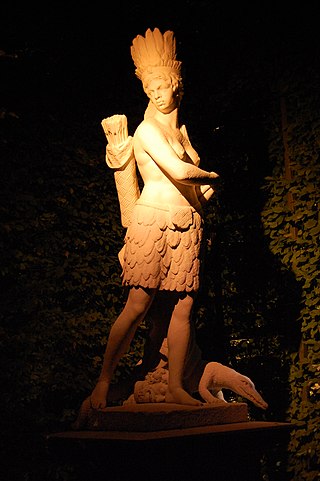
Gilles Guérin (1611–1678) was a French sculptor, who created tomb sculptures and decorative sculptures for interiors, which were executed in a Baroque idiom. He was born and died in Paris. He was a pupil of the sculptor Nicolas Le Brun, the father of the painter Charles Le Brun.

Pierre Le Gros the Elder was a French sculptor in the service of King Louis XIV.
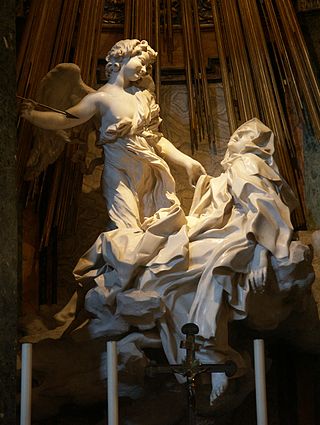
Baroque sculpture is the sculpture associated with the Baroque style of the period between the early 17th and mid 18th centuries. In Baroque sculpture, groups of figures assumed new importance, and there was a dynamic movement and energy of human forms—they spiralled around an empty central vortex, or reached outwards into the surrounding space. Baroque sculpture often had multiple ideal viewing angles, and reflected a general continuation of the Renaissance move away from the relief to sculpture created in the round, and designed to be placed in the middle of a large space—elaborate fountains such as Gian Lorenzo Bernini‘s Fontana dei Quattro Fiumi, or those in the Gardens of Versailles were a Baroque speciality. The Baroque style was perfectly suited to sculpture, with Bernini the dominating figure of the age in works such as The Ecstasy of St Theresa (1647–1652). Much Baroque sculpture added extra-sculptural elements, for example, concealed lighting, or water fountains, or fused sculpture and architecture to create a transformative experience for the viewer. Artists saw themselves as in the classical tradition, but admired Hellenistic and later Roman sculpture, rather than that of the more "Classical" periods as they are seen today.

Jacques Prou (1655–1706) was a French Academic Baroque sculptor, a product of the Academy system overseen by Charles Le Brun. Trained in the Academy school in Paris. he spent four years (1676–80) refining his style at the French Academy in Rome, then returned to Paris to become a member of the team of the Bâtiments du Roi from 1681, providing sculpture for Versailles in the atelier of Jean-Baptiste Tuby, whose daughter he married. He was received as a full member of the Académie royale de peinture et de sculpture in 1682, presenting as his reception piece a bas-relief of Sculpture consulting Painting over the portrait of Louis XIV, now at the Musée du Louvre, which reveals his concern for surface textures adapted from the dominant art, painting At Versailles he became closely associated in projects for fountains and emblematic decorative sculpture with Antoine Coysevox, notably in the Escalier des princes, the salon opening onto it, and the Salon de la Guerre.

Louis Lerambert was a French sculptor in a Parisian family that included four generations of court artists. who in 1637 inherited the court position caring for the Antiquities and Marbles of the King, which had become hereditary in his family. He trained in the atelier of Simon Vouet, recently returned from Rome; there he met the sculptor Jacques Sarazin.
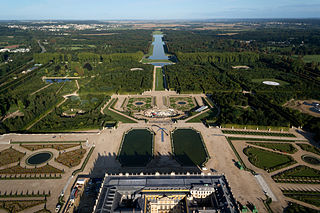
The Gardens of Versailles occupy part of what was once the Domaine royal de Versailles, the royal demesne of the château of Versailles. Situated to the west of the palace, the gardens cover some 800 hectares of land, much of which is landscaped in the classic French formal garden style perfected here by André Le Nôtre. Beyond the surrounding belt of woodland, the gardens are bordered by the urban areas of Versailles to the east and Le Chesnay to the north-east, by the National Arboretum de Chèvreloup to the north, the Versailles plain to the west, and by the Satory Forest to the south.

The French formal garden, also called the jardin à la française, is a style of "landscape" garden based on symmetry and the principle of imposing order on nature. Its epitome is generally considered to be the Gardens of Versailles designed during the 17th century by the landscape architect André Le Nôtre for Louis XIV and widely copied by other European courts.
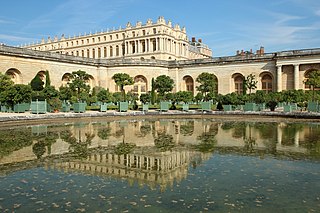
The Versailles Orangerie was built by Jules Hardouin-Mansart between 1684 and 1686, before work on the Château de Versailles had even begun. The Orangerie, which replaced Louis Le Vau's earlier design from 1663, is an example of many such prestigious extensions of grand gardens in Europe designed both to shelter tender plants and impress visitors. With the addition of the Orangerie, the gardens, no longer reserved solely for use by Louis XIV, had the added use of a theatrical setting that could be used to entertain guests at court.

Fountains in France provided drinking water to the inhabitants of the ancient Roman cities of France, and to French monasteries and villages during the Middle Ages. Later, they were symbols of royal power and grandeur in the gardens of the kings of France. Today, though they no longer provide drinking water, they decorate the squares and parks of French cities and towns.

Jean Cornu was a French sculptor, most of whose works were designed for the gardens of the Palace of Versailles.
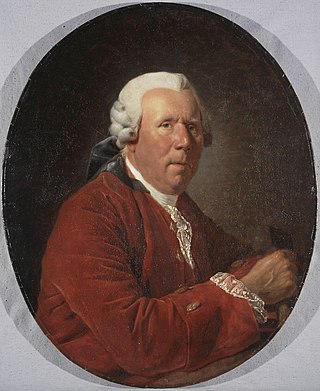
Nicolas-Sébastien Adam, also called "Adam the Younger", was a French sculptor working in the Neoclassical style. He was born in Nancy and died in Paris.

The Baroque garden was a style of garden based upon symmetry and the principle of imposing order on nature. The style originated in the late-16th century in Italy, in the gardens of the Vatican and the Villa Borghese gardens in Rome and in the gardens of the Villa d'Este in Tivoli, and then spread to France, where it became known as the jardin à la française or French formal garden. The grandest example is found in the Gardens of Versailles designed during the 17th century by the landscape architect André Le Nôtre for Louis XIV. In the 18th century, in imitation of Versailles, very ornate Baroque gardens were built in other parts of Europe, including Germany, Austria, Spain, and in Saint-Petersburg, Russia. In the mid-18th century the style was replaced by the less geometric and more natural English landscape garden.

The Louis XIV style or Louis Quatorze, also called French classicism, was the style of architecture and decorative arts intended to glorify King Louis XIV and his reign. It featured majesty, harmony and regularity. It became the official style during the reign of Louis XIV (1643–1715), imposed upon artists by the newly established Académie royale de peinture et de sculpture and the Académie royale d'architecture. It had an important influence upon the architecture of other European monarchs, from Frederick the Great of Prussia to Peter the Great of Russia. Major architects of the period included François Mansart, Jules Hardouin Mansart, Robert de Cotte, Pierre Le Muet, Claude Perrault, and Louis Le Vau. Major monuments included the Palace of Versailles, the Grand Trianon at Versailles, and the Church of Les Invalides (1675–1691).


